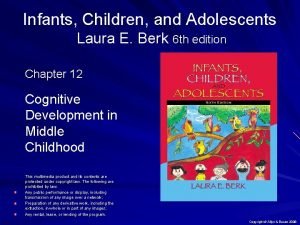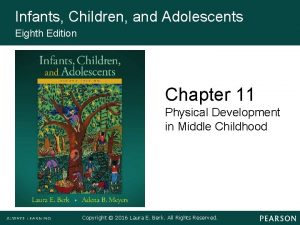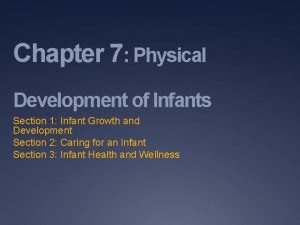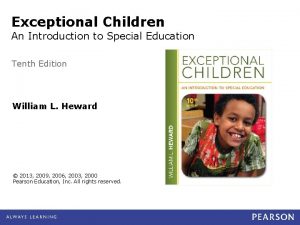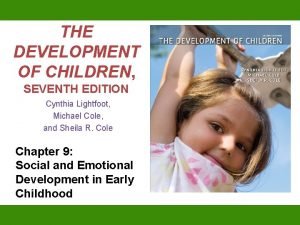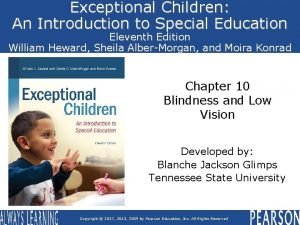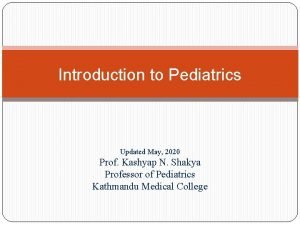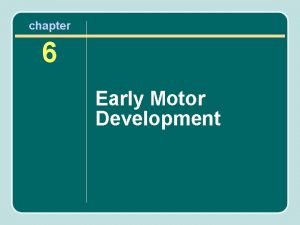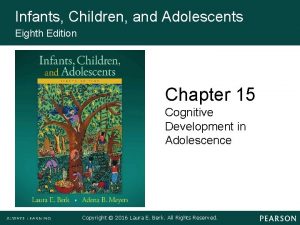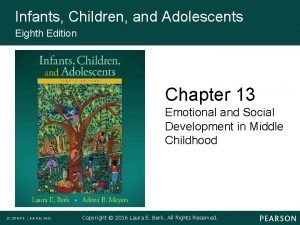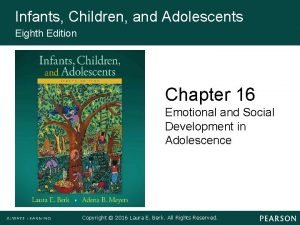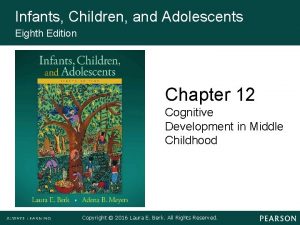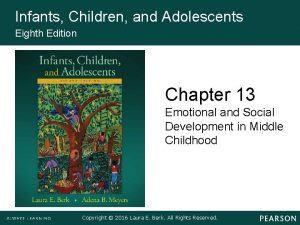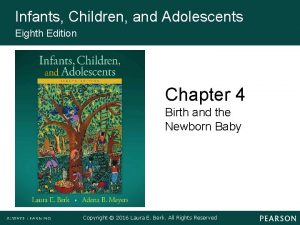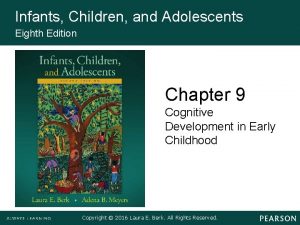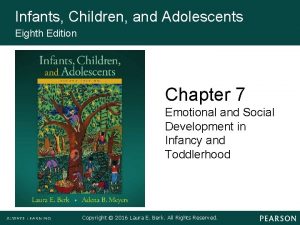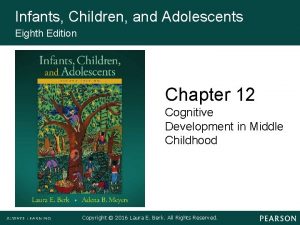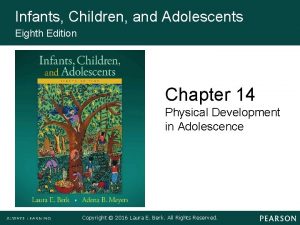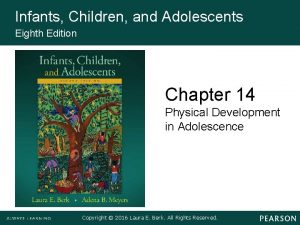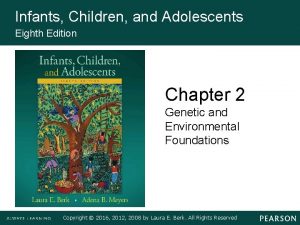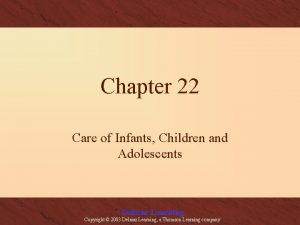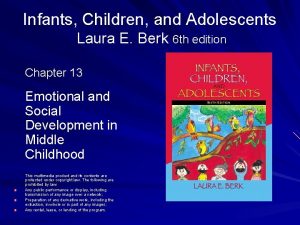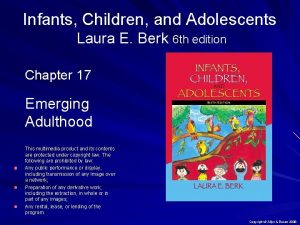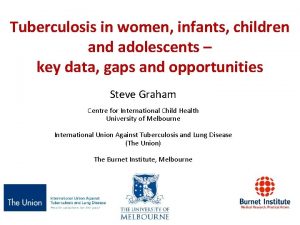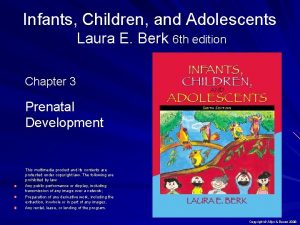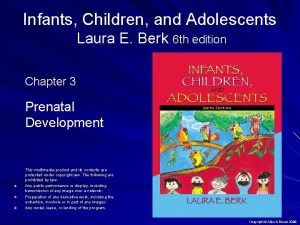Infants Children and Adolescents Eighth Edition Chapter 8






































- Slides: 38

Infants, Children, and Adolescents Eighth Edition Chapter 8 Physical Development in Early Childhood Copyright © 2016 Laura E. Berk. All Rights Reserved.

Learning Objectives (1 of 2) Early Childhood • • 1. Describe changes in body size, proportions, and skeletal maturity during early childhood. 2. Describe brain development in early childhood. 3. Explain how heredity influences physical growth. 4. Describe the effects of emotional well-being, restful sleep, nutrition, and infectious disease on physical growth and health in early childhood. Copyright © 2016 Laura E. Berk. All Rights Reserved.

Learning Objectives (2 of 2) • 5. What factors increase the risk of unintentional injuries, and how can childhood injuries be prevented? 6. Cite major milestones of gross- and fine-motor development in early childhood. • 7. Describe individual differences in preschoolers’ motor skills and ways to enhance motor development in early childhood. Copyright © 2016 Laura E. Berk. All Rights Reserved.

Physical Development in Early Childhood Body growth slows: • Child’s shape becomes more streamlined. • Individual differences in size become more apparent. Skeletal growth continues: • New epiphyses emerge. • Primary teeth are replaced by permanent teeth. Copyright © 2016 Laura E. Berk. All Rights Reserved.

Body Growth During Early Childhood Figure 8. 1 Photos of Wilson: Diahanne Lucas; Photos of Mariel: © Jim West Photography Copyright © 2016 Laura E. Berk. All Rights Reserved.

Brain Development • Between ages 2 and 6, the brain – increases to 90% of its adult weight. – undergoes reshaping and refining. • Preschoolers improve in – physical coordination. – perception, attention, and memory. – language. – logical thinking. – imagination. Copyright © 2016 Laura E. Berk. All Rights Reserved.

Brain Development (continued) • Brain plasticity – ensures that child will acquire certain abilities even if some brain areas are damaged. – declines as synaptic pruning occurs. • Cognitive functions increasingly localize in distinct neural systems. • Rapid growth occurs in prefrontal-cortical areas devoted to executive function. Copyright © 2016 Laura E. Berk. All Rights Reserved.

Handedness • Reflects greater capacity of dominant cerebral hemisphere to carry out skilled motor action. • Begins as early as tenth prenatal week. • Affected by prenatal events, practice, and culture. • Early damage to left hemisphere may cause shift in handedness, but most left-handers have no developmental problems. • Unusual lateralization may have certain advantages. Copyright © 2016 Laura E. Berk. All Rights Reserved.

Cross-Section of the Human Brain • Cerebellum: structure that aids in balance and control of body movement • Reticular formation: structure in brain stem that maintains alertness and consciousness • Hippocampus: inner-brain structure that plays a vital role in memory and spatial understanding • Amygdala: inner-brain structure that processes novelty and emotional information • Corpus callosum: large bundle of fibers connecting the two cerebral hemispheres Copyright © 2016 Laura E. Berk. All Rights Reserved.

Cross-Section of the Human Brain Figure 8. 2 Copyright © 2016 Laura E. Berk. All Rights Reserved.

Influences on Physical Growth and Health • Heredity and hormones • Emotional well-being • Sleep habits and problems • Nutrition • Infectious disease • Childhood injuries Copyright © 2016 Laura E. Berk. All Rights Reserved.

Low-Level Lead Exposure and Children’s Development • Longitudinal studies show negative relationship between lead exposure and IQ. • Since 1980, laws limiting lead content of paint and mandating lead-free gasoline have led to a sharp decline in children’s lead levels. • Low-SES children are more likely to live in lead -contaminated areas and to experience risks that magnify lead-induced damage. Copyright © 2016 Laura E. Berk. All Rights Reserved.

Relationship of Lead Exposure to 11 - to 13 -Year-Olds’ IQ by SES Figure 8. 3 (Based on Tong, Mc. Michael, & Baghurst, 2000. ) Copyright © 2016 Laura E. Berk. All Rights Reserved.

Heredity and Hormones • Children’s physical size and growth rate are related to their parents’. • Genes influence growth by controlling hormone production. • Pituitary gland releases two growth-inducing hormones: – Growth hormone (GH) is necessary for development of almost all body tissues. – Thyroid-stimulating hormone (TSH) prompts release of thyroxine, needed for brain development and for full impact of GH. Copyright © 2016 Laura E. Berk. All Rights Reserved.

Emotional Well-Being • Children’s emotional well-being profoundly affects their growth and health. • High stress suppresses release of GH. • Extreme emotional deprivation can lead to psychosocial dwarfism, characterized by – decreased secretion of GH and melatonin. – very short stature and immature skeletal age. – serious adjustment problems. Copyright © 2016 Laura E. Berk. All Rights Reserved.

Sleep Habits and Problems • Sleep contributes to body growth and cognitive performance. • Sleep difficulties are associated with impaired cognitive performance. • Children’s poor sleep affects parents’ sleep, generating family stress. • Variations by ethnicity are seen in napping, bedtime routines, and cosleeping. Copyright © 2016 Laura E. Berk. All Rights Reserved.

Sleeping Arrangements of U. S. 3 -Year-Olds by Ethnicity Figure 8. 4 (Based on Milan, Snow, & Belay, 2007. ) Copyright © 2016 Laura E. Berk. All Rights Reserved.

Nutrition • Appetite becomes unpredictable. • Most preschoolers prefer familiar foods. • Social environment influences food choices: – Children imitate food choices of people they admire. – Repeated, unpressured exposure to new foods increases acceptance. – Emotional climate at mealtimes has powerful impact. – Restricting foods increases child’s desire for those foods. – Children living in poverty may lack access to sufficient high-quality food. Copyright © 2016 Laura E. Berk. All Rights Reserved.

Dietary Deficiencies in Early Childhood • Most common dietary deficiencies of preschool years: – Protein – Essential vitamins and minerals: iron, calcium, zinc, vitamin A, vitamin C • Effects of nutritionally deficient diet: – – Small size Attention and memory difficulties Poorer intelligence and achievement test scores Hyperactivity and aggression Copyright © 2016 Laura E. Berk. All Rights Reserved.

Encouraging Good Nutrition • Offer a varied, healthy diet. • Offer predictable meals and several snacks daily. • Serve small portions, and allow the child to have seconds. • Offer healthy new foods repeatedly and patiently. • Keep mealtimes pleasant and noncoercive. • Avoid using food as a reward or restricting access to certain foods. Copyright © 2016 Laura E. Berk. All Rights Reserved.

Infectious Disease and Malnutrition • Poor diet depresses the immune system, making children susceptible to disease. • Disease contributes to malnutrition, hindering physical growth and cognitive development. • Widespread diarrhea in developing countries leads to 1 million childhood deaths annually: – Impairment and death can be prevented with oral rehydration therapy (ORT). – Zinc supplements also reduce incidence of diarrhea. Copyright © 2016 Laura E. Berk. All Rights Reserved.

Immunization • Widespread immunization has led to dramatic decline in childhood diseases in industrialized nations. • About 20% of U. S. infants and toddlers and 17% of preschoolers are not fully immunized: – Many low-income families lack health insurance coverage or a primary-care physician. – Some parents believe discredited media reports of a link between vaccination and autism. – Public education on immunization is badly needed. Copyright © 2016 Laura E. Berk. All Rights Reserved.

Otitis Media and Development • Otitis media (middle ear infection) is most common between 6 months and 3 years. • Rates nearly double in children who attend child-care centers. • Frequent cases can disrupt language and academic progress. • Prevention: – Frequent screening – Prompt medical attention – Infection control in child-care settings – Verbally stimulating adult–child interaction – Vaccines Copyright © 2016 Laura E. Berk. All Rights Reserved.

Factors Related to Childhood Injuries • Injuries occur within a complex ecological system of influences. • Individual differences: – Gender – Temperament • Family, community, and societal factors: – Poverty, single parenthood, low parental education – Child-care shortages, teenage parenthood – Societal conditions in developing nations Copyright © 2016 Laura E. Berk. All Rights Reserved.

International Death Rates due to Childhood Injury Figure 8. 6 (Based on World Health Organization, 2008. ) Copyright © 2016 Laura E. Berk. All Rights Reserved.

Preventing Childhood Injuries • Laws prevent many injuries (car safety seats, child-resistant caps, flameproof clothing). • Many parents and children behave in ways that compromise safety: – Safety seats: 27% of U. S. parents don’t use them; of those who do, 40% to 84% use them incorrectly. – Parents overestimate children’s knowledge of safety rules, rather than monitoring and controlling access to hazards. Copyright © 2016 Laura E. Berk. All Rights Reserved.

Reducing Unintentional Injuries • Provide age-appropriate supervision and safety instruction. • Know the child’s temperament. • Eliminate the most serious dangers from the home. • Always restrain children properly in back seat of car. • Select safe playground equipment and sites. • Be extra cautious around water. • Practice safety around animals. Copyright © 2016 Laura E. Berk. All Rights Reserved.

Motor Skill Development in Early Childhood Gross-motor skills: • Walking, running, jumping, hopping • Catching, throwing, swinging, riding Fine-motor skills: • Self-help: dressing, eating • Drawing: line and circle, tadpole image Copyright © 2016 Laura E. Berk. All Rights Reserved.

Changes in Throwing During Early Childhood Figure 8. 7 (Adapted figures drawn from film tracings taken in the Motor Development and Child Study Laboratory, University of Wisconsin–Madison and now available from the Motor Development Film Collection, Kinesiology Division, Bowling Green State University. © Mary Ann Roberton. Reprinted by permission of Mary Ann Roberton. ) Copyright © 2016 Laura E. Berk. All Rights Reserved.

Changes in Gross- and Fine-Motor Skills During Early Childhood Age Gross-Motor Skills Fine-Motor Skills 2– 3 years • • • 3– 4 years • • 4– 5 years 5– 6 years • • Jumps, hops, throws, and catches with rigid upper body Pushes riding toy with feet; little steering Jumps and hops, flexing upper body Throws and catches with slight upper-body involvement Pedals and steers tricycle Runs more smoothly Gallops and skips Throws with increased body rotation Increases running speed Mature throwing, catching Rides bicycle with training wheels Copyright © 2016 Laura E. Berk. All Rights Reserved. • • • Puts on and removes simple items of clothing Uses large zippers Uses spoon effectively Fastens and unfastens large buttons Serves self food without help Uses scissors Draws first picture of person Uses fork effectively Cuts with scissors following line Copies shapes and some letters • • Uses knife Ties shoes Draws more detailed person Copies numbers and simple words • • •

Progression of Drawing Skills Scribbles: during second year First representational forms: • Around age 3: Labels already-made drawings. • Age 3– 4: Draws boundaries and tadpole-shaped people. More realistic drawings: preschool to school age Early printing: ages 4– 6 Copyright © 2016 Laura E. Berk. All Rights Reserved.

Progression of Drawing Skills Figure 8. 8 (Left: From H. Gardner, 1980, Artful Scribbles: The Significance of Children’s Drawing, New York: Basic Books, p. 64. Copyright © 1980 by Howard Gardner. Reprinted by permission of Basic Books, a member of the Perseus Books, conveyed through Copyright Clearance Center. Right: From E. Winner, “Where Pelicans Kiss Seals, ” Psychology Today, 20[8], August 1986, p. 35. Reprinted by permission from the collection of Ellen Winner. ) Copyright © 2016 Laura E. Berk. All Rights Reserved.

Development of Children’s Drawings of Geometric Objects Figure 8. 9 (Based on Toomela, 1999. ) Copyright © 2016 Laura E. Berk. All Rights Reserved.

Chinese Children’s Advanced Drawing Skills • Several cultural factors promote advanced drawing skills in Chinese children: – 4, 000 -year-old artistic tradition – Belief that creativity must build on a foundation of artistic knowledge and techniques – Instruction in painting using prescribed brush strokes – Writing instruction that emphasizes details of characters • In contrast, U. S. art education is more diverse and emphasizes independence and self-expression. Copyright © 2016 Laura E. Berk. All Rights Reserved.

Development of Printing Up to age 3 Ages 4– 6 • Scribbles • Varied pencil grips • Gradual realization that writing stands for language • Identification of individual letters • Adult pencil grip by age 5 Copyright © 2016 Laura E. Berk. All Rights Reserved.

Variations in 3 -Year-Olds’ Pencil Grip Figure 8. 11 (Based on Greer & Lockman, 1998. ) Copyright © 2016 Laura E. Berk. All Rights Reserved.

Individual Differences in Motor Skills Body build: • Taller, more muscular bodies move more quickly, acquire skills earlier. Sex: • Boys are ahead in skills requiring power and force. • Girls are advantaged in fine-motor skills and in skills requiring good balance and foot movement. • Social pressures channel children into activities. Copyright © 2016 Laura E. Berk. All Rights Reserved.

Enhancing Early Childhood Motor Development • Motor skills are best mastered through everyday play: – Formal lessons have little added impact. – Preschoolers should have at least 60 minutes a day of adult-structured play, plus several hours of child-directed play. – Children need appropriate play spaces and equipment. • Daily routines support fine-motor development. Copyright © 2016 Laura E. Berk. All Rights Reserved.
 Infants, children and adolescents 8th edition
Infants, children and adolescents 8th edition Lara berk
Lara berk Gains in perspective taking permit the transition to
Gains in perspective taking permit the transition to Infants and children 8th edition
Infants and children 8th edition Psychology eighth edition david g myers
Psychology eighth edition david g myers David g myers psychology 8th edition
David g myers psychology 8th edition Operations management eighth edition
Operations management eighth edition The fifth, sixth, seventh, and eighth amendments protect *
The fifth, sixth, seventh, and eighth amendments protect * Adolescents defenition
Adolescents defenition Intellectual development of infants chapter 9
Intellectual development of infants chapter 9 Chapter 7 physical development of infants
Chapter 7 physical development of infants Anagram of eighth
Anagram of eighth Matching planet rings
Matching planet rings Nearest quarter inch
Nearest quarter inch What is the eighth commandment catholic
What is the eighth commandment catholic Taj mahal 8th wonder of the world
Taj mahal 8th wonder of the world Three quarter crown
Three quarter crown Eighth amendment excessive bail
Eighth amendment excessive bail Eighth letter of the alphabet
Eighth letter of the alphabet Eighth amendment excessive bail
Eighth amendment excessive bail What's the 5th amendment
What's the 5th amendment Exceptional children 10th edition
Exceptional children 10th edition The development of children 7th edition
The development of children 7th edition Gordon lightfoot ethnicity
Gordon lightfoot ethnicity Exceptional children an introduction to special education
Exceptional children an introduction to special education Exceptional children 10th edition
Exceptional children 10th edition Mis chapter 6
Mis chapter 6 Report
Report Creative curriculum intentional teaching cards
Creative curriculum intentional teaching cards Rsv nursing diagnosis
Rsv nursing diagnosis Infants age range
Infants age range Give me a dozen healthy infants well-formed meaning
Give me a dozen healthy infants well-formed meaning Sentinel injuries
Sentinel injuries Junior infants art ideas
Junior infants art ideas Infants display a wide range of emotional expressions
Infants display a wide range of emotional expressions Derotative righting reflex
Derotative righting reflex Length board for infants
Length board for infants Que son datos discretos y continuos
Que son datos discretos y continuos Just phonics junior infants
Just phonics junior infants

